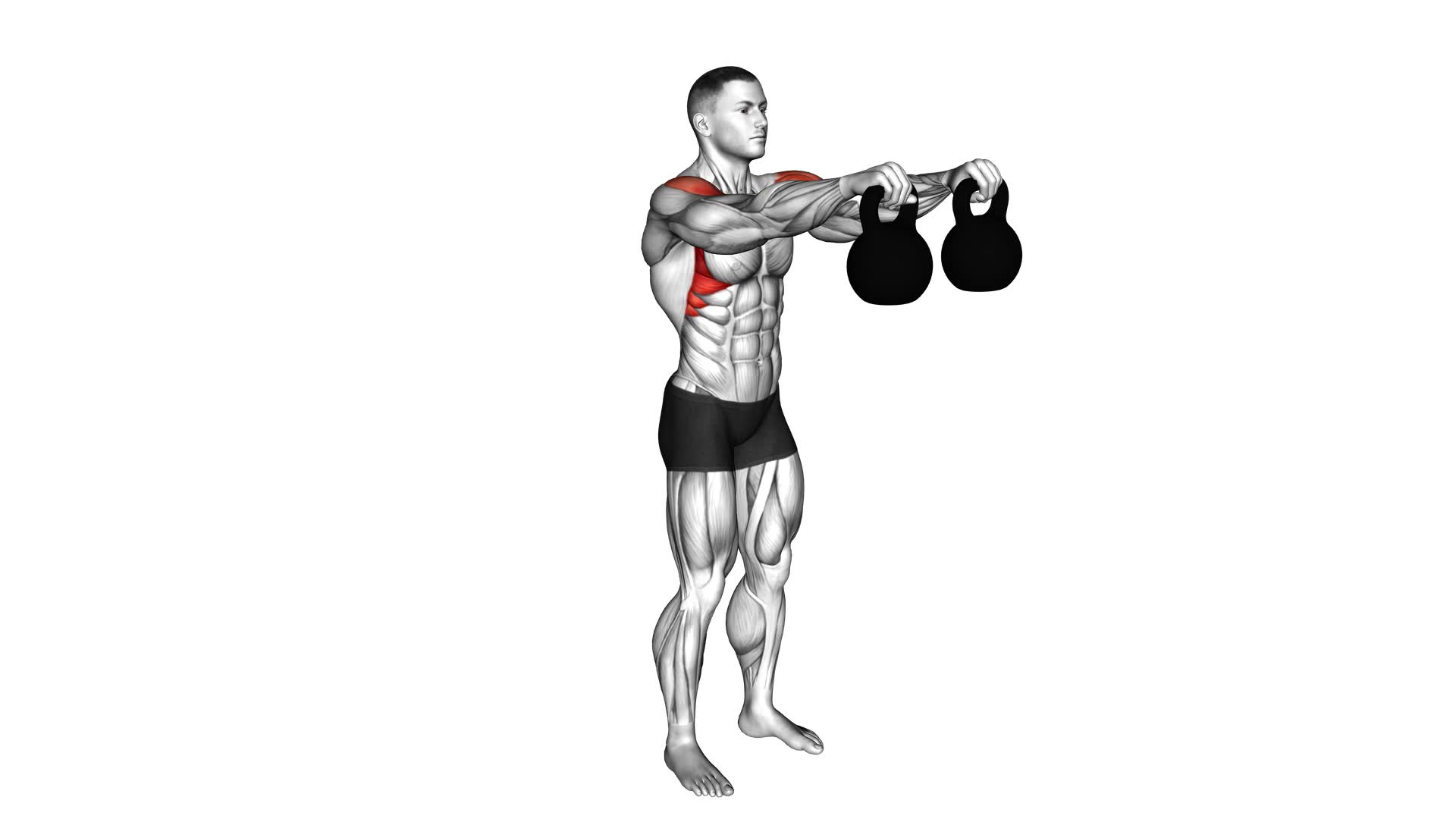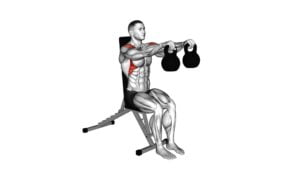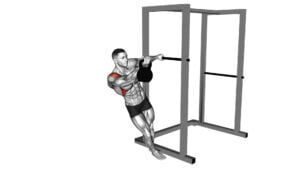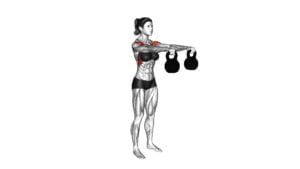Kettlebell Front Raise – Video Exercise Guide & Tips

Are you looking for a quick and effective way to strengthen your shoulders and upper body? Look no further than the kettlebell front raise!
Watch This Exercise Video
In this video exercise guide, we'll show you how to properly perform this exercise, along with tips to maximize your results. Whether you're a beginner or advanced, this exercise can be easily modified to fit your fitness level.
Get ready to tone and sculpt your muscles with the kettlebell front raise. Let's get started!
Key Takeaways
- Kettlebell front raise strengthens shoulders and upper body.
- Proper form and technique are important to maintain a strong and stable position.
- Variations such as performing on an unstable surface or holding the kettlebell upside down can add difficulty.
- Common mistakes to avoid include using too heavy of a kettlebell and relying on momentum instead of shoulder muscles.
Benefits of Kettlebell Front Raise
Discover the benefits of the kettlebell front raise for stronger shoulders and improved upper body strength. This exercise is highly effective in improving shoulder strength and targeting the anterior deltoids. By incorporating the kettlebell front raise into your workout routine, you can specifically focus on strengthening and toning these important muscles.
The kettlebell front raise is a compound exercise that engages multiple muscle groups in the upper body. It primarily targets the anterior deltoids, which are the muscles located at the front of your shoulders. By working these muscles, you can enhance your overall shoulder strength and stability.
In addition to targeting the anterior deltoids, the kettlebell front raise also engages the muscles in your upper back, chest, and arms. This exercise helps to improve your posture and develop a strong upper body.
To perform the kettlebell front raise properly, start by holding a kettlebell in each hand with your palms facing down. Stand with your feet shoulder-width apart and keep your core engaged. Lift the kettlebells in front of you, making sure to keep your arms straight and your shoulders relaxed. Slowly lower the kettlebells back down to the starting position.
Proper Form and Technique
To perform the kettlebell front raise with proper form and technique, you need to focus on maintaining a strong and stable position while engaging multiple muscle groups in your upper body. Start by standing with your feet shoulder-width apart and holding the kettlebell in front of your thighs, palms facing down. Keep your core engaged and your back straight throughout the exercise.
One common error to avoid is using momentum to lift the kettlebell. Instead, use controlled movements to raise the kettlebell in front of you until your arms are parallel to the ground. Avoid arching your back or shrugging your shoulders as you lift the weight.
Another important aspect of proper form is to maintain correct posture. This means keeping your chest lifted, shoulders relaxed, and chin parallel to the ground. Avoid hunching your shoulders or rounding your upper back.
By maintaining proper form and technique, you'll effectively target your deltoids, upper back, and core muscles.
Once you have mastered the basic kettlebell front raise, you can move on to variations for added difficulty, such as performing the exercise on an unstable surface or increasing the weight of the kettlebell.
Variations for Added Difficulty
To increase the difficulty of the kettlebell front raise, try performing the exercise on an unstable surface. This challenges your core stability and engages additional muscles to maintain balance.
Here are three advanced modifications you can incorporate for progressive overload:
- Single-leg kettlebell front raise: Stand on one leg while performing the front raise. This increases the demand on your stabilizing muscles and improves balance.
- Bottom-up kettlebell front raise: Hold the kettlebell upside down, with the handle pointing towards the ceiling. This variation requires greater grip strength and stability, as well as increased focus and control.
- Kettlebell front raise with pause: Add a pause at the top of the movement, holding the kettlebell at shoulder height for a few seconds before lowering it back down. This increases time under tension and maximizes muscle activation.
Remember to start with a weight that allows you to maintain proper form and gradually increase the load as you become stronger. These advanced variations provide a challenging way to continue progressing and achieving your fitness goals.
Common Mistakes to Avoid
Avoid making these common mistakes when performing the kettlebell front raise exercise:
- Using too heavy of a kettlebell. This can lead to improper form and strain on your muscles. To correct this, start with a lighter kettlebell and gradually increase the weight as you build strength and improve your technique.
- Using momentum to lift the kettlebell instead of relying on your shoulder muscles. This can be corrected by focusing on slow and controlled movements, ensuring that your shoulder muscles are doing the work.
- Arching your back or shrugging your shoulders during the exercise. Maintain a neutral spine and engage your core to stabilize your body.
- Being mindful of your grip. Holding the kettlebell too tightly can cause unnecessary tension in your forearm muscles. Instead, grip the kettlebell firmly but not excessively.
By avoiding these common mistakes and making the necessary corrections, you can perform the kettlebell front raise exercise effectively and safely.
Now, let's move on to the next section to learn some tips for maximizing your results.
Tips for Maximizing Results
To maximize your results with the kettlebell front raise exercise, focus on proper form and engage your shoulder muscles throughout the movement.
Here are three tips to help you get the most out of this exercise:
- Maximizing intensity: To increase the intensity of the kettlebell front raise, try using a heavier kettlebell or increasing the number of repetitions. You can also incorporate supersets or circuit training to keep your heart rate up and challenge your muscles even more. Remember to listen to your body and gradually increase the intensity to avoid injury.
- Best time to perform: The kettlebell front raise can be performed at any time during your workout, but it's most effective when done as part of a shoulder or upper body routine. By placing it towards the beginning of your workout, you can ensure that your muscles are fresh and able to handle the load. However, if you prefer to use it as a finisher exercise, make sure to warm up adequately beforehand.
- Proper technique: To get the most out of the kettlebell front raise, start with your feet shoulder-width apart and hold the kettlebell with an overhand grip. Lift the kettlebell in a controlled manner, keeping your core engaged and your shoulders down and back. Avoid using momentum to swing the kettlebell and focus on using your shoulder muscles to lift the weight.
Frequently Asked Questions
How Many Calories Can Be Burned by Doing Kettlebell Front Raises?
When you perform kettlebell front raises, you can burn calories while working on your form and technique. The amount of calories burned can vary depending on factors such as your weight, intensity, and duration of the exercise.
By engaging your core, shoulders, and arms, this exercise can help you build strength and improve your overall fitness.
Remember to maintain proper form and technique to maximize the benefits and minimize the risk of injury.
Can Kettlebell Front Raises Help With Improving Posture?
Kettlebell front raises can definitely help improve your posture. By targeting your shoulder and upper back muscles, this exercise strengthens the muscles that support your spine, helping you maintain a more upright position.
The benefits of kettlebell front raises go beyond just posture improvement. They also help enhance shoulder stability, increase upper body strength, and promote better balance.
To perform this exercise correctly, maintain a proper grip on the kettlebell and lift it in a controlled manner, focusing on engaging your shoulder and upper back muscles.
Are Kettlebell Front Raises Suitable for Beginners?
Kettlebell front raises can be a great exercise for beginners looking to strengthen their shoulder muscles. By incorporating proper kettlebell front raise techniques, you can target your anterior deltoids effectively.
However, it's important to be mindful of common mistakes beginners make, such as using too heavy of a weight or swinging the kettlebell. Start with lighter weights and focus on maintaining proper form throughout the movement to ensure a safe and effective workout.
Can Kettlebell Front Raises Specifically Target the Shoulders?
Yes, kettlebell front raises can specifically target the shoulders. They're a great exercise for building strength and definition in the shoulder muscles. Compared to dumbbell front raises, kettlebell front raises can be more effective because the off-centered weight of the kettlebell increases the challenge on your shoulder muscles.
You can incorporate kettlebell front raises into your full body workout routine by performing them as a part of your shoulder or upper body workout.
Are Kettlebell Front Raises Beneficial for Athletes in Other Sports, Such as Basketball or Tennis?
Kettlebell front raises can be beneficial for athletes in other sports, such as basketball or tennis. These variations of the exercise help to target the shoulders, improving overall strength and stability.
Incorporating kettlebell front raises into your training routine can enhance your performance on the court or field. By engaging the shoulder muscles, this exercise can help to prevent injuries and increase power in your upper body movements.
Conclusion
To conclude, the kettlebell front raise is a highly effective exercise for targeting the shoulders and improving upper body strength. By using proper form and technique, you can maximize the benefits of this exercise.
Additionally, incorporating variations for added difficulty can challenge your muscles even further. Avoid common mistakes and follow the tips provided to ensure you achieve the best results from this exercise.
Keep pushing yourself and enjoy the benefits of a stronger, more defined upper body.

Author
Years ago, the spark of my life’s passion ignited in my mind the moment I stepped into the local gym for the first time. The inaugural bead of perspiration, the initial endeavor, the very first surge of endorphins, and a sense of pride that washed over me post-workout marked the beginning of my deep-seated interest in strength sports, fitness, and sports nutrition. This very curiosity blossomed rapidly into a profound fascination, propelling me to earn a Master’s degree in Physical Education from the Academy of Physical Education in Krakow, followed by a Sports Manager diploma from the Jagiellonian University. My journey of growth led me to gain more specialized qualifications, such as being a certified personal trainer with a focus on sports dietetics, a lifeguard, and an instructor for wellness and corrective gymnastics. Theoretical knowledge paired seamlessly with practical experience, reinforcing my belief that the transformation of individuals under my guidance was also a reflection of my personal growth. This belief holds true even today. Each day, I strive to push the boundaries and explore new realms. These realms gently elevate me to greater heights. The unique combination of passion for my field and the continuous quest for growth fuels my drive to break new ground.







